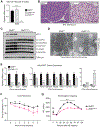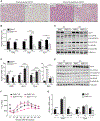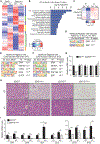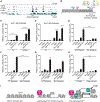Early B Cell Factor Activity Controls Developmental and Adaptive Thermogenic Gene Programming in Adipocytes
- PMID: 32130892
- PMCID: PMC7079313
- DOI: 10.1016/j.celrep.2020.02.023
Early B Cell Factor Activity Controls Developmental and Adaptive Thermogenic Gene Programming in Adipocytes
Abstract
Brown adipose tissue (BAT) activity protects animals against hypothermia and represents a potential therapeutic target to combat obesity. The transcription factor early B cell factor-2 (EBF2) promotes brown adipocyte differentiation, but its roles in maintaining brown adipocyte fate and in stimulating BAT recruitment during cold exposure were unknown. We find that the deletion of Ebf2 in adipocytes of mice ablates BAT character and function, resulting in cold intolerance. Unexpectedly, prolonged exposure to cold restores the thermogenic profile and function of Ebf2 mutant BAT. Enhancer profiling and genetic assays identified EBF1 as a candidate regulator of the cold response in BAT. Adipocyte-specific deletion of both Ebf1 and Ebf2 abolishes BAT recruitment during chronic cold exposure. Mechanistically, EBF1 and EBF2 promote thermogenic gene transcription through increasing the expression and activity of ERRα and PGC1α. Together, these studies demonstrate that EBF proteins specify the developmental fate and control the adaptive cold response of brown adipocytes.
Keywords: EBF1; EBF2; ERR; PGC1; UCP1; brown adipocyte; brown fat; cold exposure; thermogenesis.
Copyright © 2020 The Author(s). Published by Elsevier Inc. All rights reserved.
Conflict of interest statement
Declaration of Interests The authors declare no competing interests.
Figures




Similar articles
-
Id1 Promotes Obesity by Suppressing Brown Adipose Thermogenesis and White Adipose Browning.Diabetes. 2017 Jun;66(6):1611-1625. doi: 10.2337/db16-1079. Epub 2017 Mar 7. Diabetes. 2017. PMID: 28270523 Free PMC article.
-
Bone morphogenic protein 9 is a novel thermogenic hepatokine secreted in response to cold exposure.Metabolism. 2022 Apr;129:155139. doi: 10.1016/j.metabol.2022.155139. Epub 2022 Jan 19. Metabolism. 2022. PMID: 35063533
-
Transcriptomic Analysis Reveals Fibroblast Growth Factor 11 (FGF11) Role in Brown Adipocytes in Thermogenic Regulation of Goats.Int J Mol Sci. 2023 Jun 29;24(13):10838. doi: 10.3390/ijms241310838. Int J Mol Sci. 2023. PMID: 37446019 Free PMC article.
-
Origins and early development of the concept that brown adipose tissue thermogenesis is linked to energy balance and obesity.Biochimie. 2017 Mar;134:62-70. doi: 10.1016/j.biochi.2016.09.007. Epub 2016 Sep 10. Biochimie. 2017. PMID: 27621146 Review.
-
Brown fat biology and thermogenesis.Front Biosci (Landmark Ed). 2011 Jan 1;16(4):1233-60. doi: 10.2741/3786. Front Biosci (Landmark Ed). 2011. PMID: 21196229 Review.
Cited by
-
Interplay between Vitamin D and Adipose Tissue: Implications for Adipogenesis and Adipose Tissue Function.Nutrients. 2023 Nov 18;15(22):4832. doi: 10.3390/nu15224832. Nutrients. 2023. PMID: 38004226 Free PMC article. Review.
-
Molecular and cellular regulation of thermogenic fat.Front Endocrinol (Lausanne). 2023 Jul 3;14:1215772. doi: 10.3389/fendo.2023.1215772. eCollection 2023. Front Endocrinol (Lausanne). 2023. PMID: 37465124 Free PMC article. Review.
-
Multifaceted Transcriptional Network of Estrogen-Related Receptor Alpha in Health and Disease.Int J Mol Sci. 2023 Feb 21;24(5):4265. doi: 10.3390/ijms24054265. Int J Mol Sci. 2023. PMID: 36901694 Free PMC article. Review.
-
Brown fat ATP-citrate lyase links carbohydrate availability to thermogenesis and guards against metabolic stress.Nat Metab. 2024 Nov;6(11):2187-2202. doi: 10.1038/s42255-024-01143-3. Epub 2024 Oct 14. Nat Metab. 2024. PMID: 39402290 Free PMC article.
-
White-to-Beige and Back: Adipocyte Conversion and Transcriptional Reprogramming.Pharmaceuticals (Basel). 2024 Jun 16;17(6):790. doi: 10.3390/ph17060790. Pharmaceuticals (Basel). 2024. PMID: 38931457 Free PMC article. Review.
References
-
- Boller S, Ramamoorthy S, Akbas D, Nechanitzky R, Burger L, Murr R, Schübeler D, and Grosschedl R (2016). Pioneering Activity of the C-Terminal Domain of EBF1 Shapes the Chromatin Landscape for B Cell Programming. Immunity 44, 527–541. - PubMed
Publication types
MeSH terms
Substances
Grants and funding
LinkOut - more resources
Full Text Sources
Molecular Biology Databases
Research Materials

